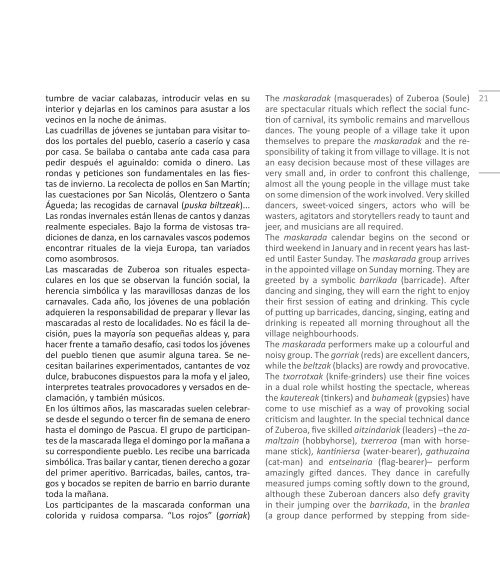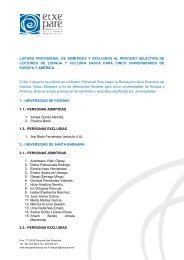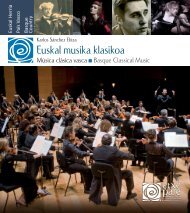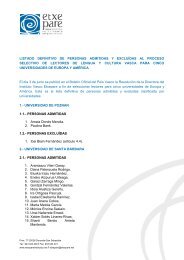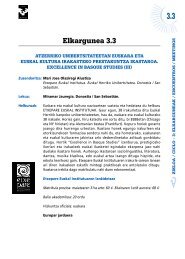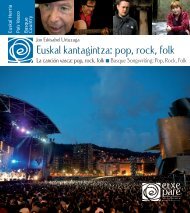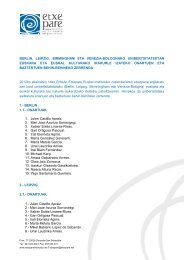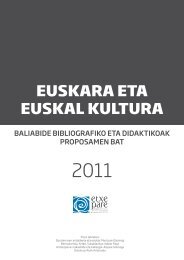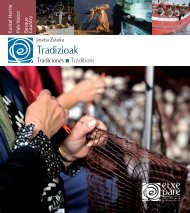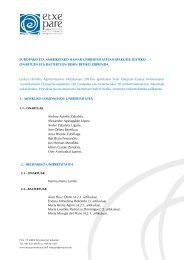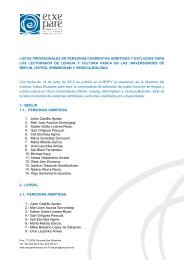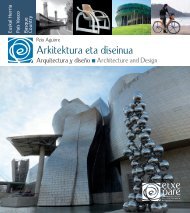Euskal dantza - Etxepare, Euskal Institutua
Euskal dantza - Etxepare, Euskal Institutua
Euskal dantza - Etxepare, Euskal Institutua
You also want an ePaper? Increase the reach of your titles
YUMPU automatically turns print PDFs into web optimized ePapers that Google loves.
tumbre de vaciar calabazas, introducir velas en suinterior y dejarlas en los caminos para asustar a losvecinos en la noche de ánimas.Las cuadrillas de jóvenes se juntaban para visitar todoslos portales del pueblo, caserío a caserío y casapor casa. Se bailaba o cantaba ante cada casa parapedir después el aguinaldo: comida o dinero. Lasrondas y peciones son fundamentales en las fiestasde invierno. La recolecta de pollos en San Marn;las cuestaciones por San Nicolás, Olentzero o SantaÁgueda; las recogidas de carnaval (puska biltzeak)...Las rondas invernales están llenas de cantos y danzasrealmente especiales. Bajo la forma de vistosas tradicionesde danza, en los carnavales vascos podemosencontrar rituales de la vieja Europa, tan variadoscomo asombrosos.Las mascaradas de Zuberoa son rituales espectacularesen los que se observan la función social, laherencia simbólica y las maravillosas danzas de loscarnavales. Cada año, los jóvenes de una poblaciónadquieren la responsabilidad de preparar y llevar lasmascaradas al resto de localidades. No es fácil la decisión,pues la mayoría son pequeñas aldeas y, parahacer frente a tamaño desao, casi todos los jóvenesdel pueblo enen que asumir alguna tarea. Se necesitanbailarines experimentados, cantantes de vozdulce, brabucones dispuestos para la mofa y el jaleo,interpretes teatrales provocadores y versados en declamación,y también músicos.En los úlmos años, las mascaradas suelen celebrarsedesde el segundo o tercer fin de semana de enerohasta el domingo de Pascua. El grupo de parcipantesde la mascarada llega el domingo por la mañana asu correspondiente pueblo. Les recibe una barricadasimbólica. Tras bailar y cantar, enen derecho a gozardel primer aperivo. Barricadas, bailes, cantos, tragosy bocados se repiten de barrio en barrio durantetoda la mañana.Los parcipantes de la mascarada conforman unacolorida y ruidosa comparsa. “Los rojos” (gorriak)The maskaradak (masquerades) of Zuberoa (Soule)are spectacular rituals which reflect the social func-on of carnival, its symbolic remains and marvellousdances. The young people of a village take it uponthemselves to prepare the maskaradak and the responsibilityof taking it from village to village. It is notan easy decision because most of these villages arevery small and, in order to confront this challenge,almost all the young people in the village must takeon some dimension of the work involved. Very skilleddancers, sweet-voiced singers, actors who will bewasters, agitators and storytellers ready to taunt andjeer, and musicians are all required.The maskarada calendar begins on the second orthird weekend in January and in recent years has lastedunl Easter Sunday. The maskarada group arrivesin the appointed village on Sunday morning. They aregreeted by a symbolic barrikada (barricade). Aerdancing and singing, they will earn the right to enjoytheir first session of eang and drinking. This cycleof pung up barricades, dancing, singing, eang anddrinking is repeated all morning throughout all thevillage neighbourhoods.The maskarada performers make up a colourful andnoisy group. The gorriak (reds) are excellent dancers,while the beltzak (blacks) are rowdy and provocave.The txorrotxak (knife-grinders) use their fine voicesin a dual role whilst hosng the spectacle, whereasthe kautereak (nkers) and buhameak (gypsies) havecome to use mischief as a way of provoking socialcricism and laughter. In the special technical danceof Zuberoa, five skilled aitzindariak (leaders) –the zamaltzain(hobbyhorse), txerreroa (man with horsemanesck), kanniersa (water-bearer), gathuzaina(cat-man) and entseinaria (flag-bearer)– performamazingly gied dances. They dance in carefullymeasured jumps coming soly down to the ground,although these Zuberoan dancers also defy gravityin their jumping over the barrikada, in the branlea(a group dance performed by stepping from side-21


